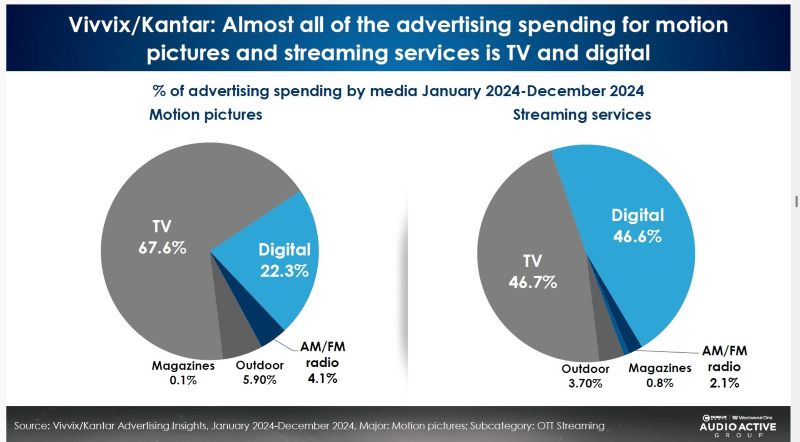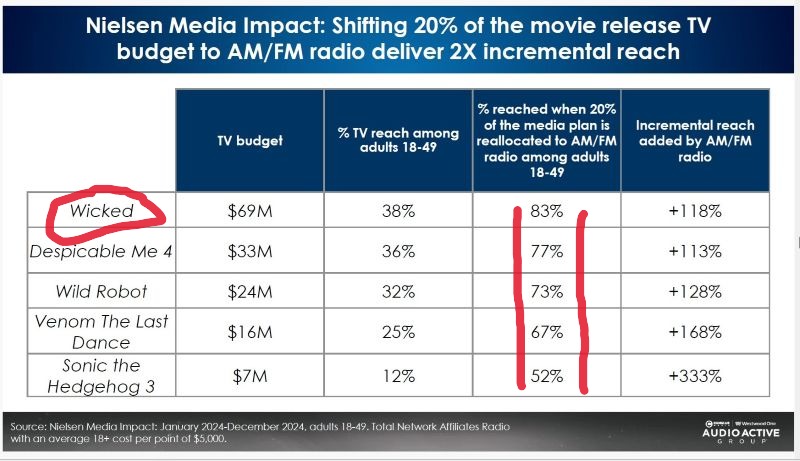The radio industry makes the case for the movie industry to shift a modest slice of its paid-advertising campaigns to double its audience reach. The pitch is to reallocate 20% of the big spending Hollywood makes in linear TV over to audio advertising, which results in no extra cost since the end-total is unchanged.
In the data grid (image above), the third column estimates the impact from reallocation of 20% TV advertising in boosting the audience reach of the movie campaign for “Wicked” to 83% of target demographic ages 18-49, from 38%. That’s a 118% increase, using the Nielsen Media Impact optimizer tool (doing a “what if” analysis). Universal Pictures released the film adaptation of “Wicked” in November, generating a blockbuster $473 million in domestic boxoffice.
Reach is defined as the percent of a target population that receive a marketing message. For example, if the target is 10 million people and it’s estimated that 3 million received the message, the reach is 30%. The memorandum cites data compiled by independent researchers Edison Research, FocalData, Maru, Screen Engine/ASI, Nielsen, Veritonic and Vivvix Kantar as validating its conclusion.
“All these various studies reveal that audio listeners are voracious consumers of movies whether in theater or video streaming service,” Pierre Bouvard, chief insights officer at Cumulus Media and Westwood One’s Audio Active Group, says in a 19-minute video.
The Westwood One initiative asserts that media research indicates radio and podcast listeners over-index as movie consumers, while viewers of linear TV (broadcast TV and cable TV channels) under-index, meaning this group averages less than the overall population in embracing movies.
Researcher Maru categorizes 15% of the population as “heavy movie goers” in their personal habits, while 23% of AM/FM radio’s audience is that heavy movie category (this is an example of over-indexing). Some 28% of podcast listeners are movie-heavies and 42% of the music streaming audience, so even more over-indexing. Meanwhile, 12% of the linear TV audience is heavy movie goers, meaning TV as a category under-index. That’s from a 2022 Maru survey.
Westwood One is the radio program arm of giant radio broadcaster Cumulus Media, which is the publicly traded company with $827 million in annual revenue that owns the former ABC Radio broadcast properties. Its memorandum sings the praises of AM/FM broadcast radio, podcasts and audio streamers (such as Spotify) — meaning audio advertising.
Of course, Westwood One has a vested interest in advocating movie marketers shift more spending to radio (at the expense of linear TV media). Such advocacy via memorandums that are circulated in industry are common in advertising and get serious consideration, since they are backed up by analysis of industry data. Someone with a vested interest can uncover kernels of wisdom.
Hollywood advertisers may be particularly receptive to new ideas for marketing because there is alarm that recently prerelease “awareness” for new movies has declined noticeably. Audiences don’t know what’s coming to theaters.
The Westwood One pitch undercuts long-standing conventional wisdom that motion pictures, as a visual medium, need “sight, sound and motion” to be marketed effectively. The retort is “You can look away from screens, but you can’t shut your ears.”
As the accompanying table with two pie-charts indicates, the memorandum notes that researcher Vivvix Kantar Advertising Insights finds movie marketers allocate 67.6% of their domestic advertising budget to the linear TV category (and just 4.1% to AM/FM radio). Meanwhile, video streamers allocate 46.7% of their advertising budget to the linear TV category (and just 2.1% to AM/FM radio). There’s “very little audio” advertising, notes Bouvard. The “video streamers” are Netflix and other platforms pitching subscriptions to their platform, and not movies alone.
Despite a heft $69 million TV ad spend for “Wicked,” Bouvard says that the linear TV advertising is missing about 60% of the target 18-49 year old target demographic, which is poor audience reach. Some films in the analysis missed 70% of the target demo.

Vivvix Kantar defines its digital category as connected TV (smart TV sets plugged into the Internet), other streaming, mobile apps, search, and display. TV is linear broadcast and cable channels.
Radio has always been noteworthy for wide reach, surpassing most other media. The effectiveness in swaying audiences with audio-only commercials is more debatable.
Taking the “sight … motion” argument head-on, Westwood One says that voice-over in radio advertising can sell movies better than pieced-together video clips that movie marketers rely on. “Have the narrator explain the plot and name the actors rather than using hard to understand, noisy clips from the movie,” asserts Westwood One. “Storytelling works.”
The Westwood One memorandum comes as the ascendance of audio media may be unfolding. Though not stated, President Trump’s election victory provides some validation of recent digital and audio supremacy. Trump’s podcast interviews (particularly with Joe Rogan) are believed to have been highly influential.
Related content:

Leave a Reply